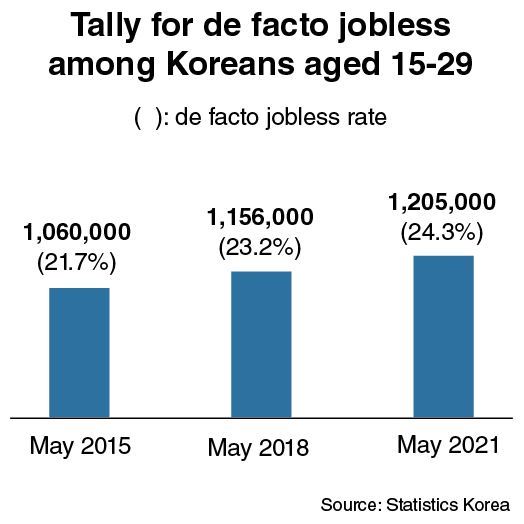[News Focus] 1 in 4 Koreans aged 15-29 still de facto jobless
By Kim Yon-sePublished : June 22, 2021 - 14:54

SEJONG -- The tally for unemployed or underemployed young people in South Korea remains at a serious level, despite recent improvement in the hiring market.
The de facto jobless -- unemployed plus underemployed -- among those aged 15-29 was 1.011 million in December 2019, a month before COVID-19 initially hit the nation, according to the Supplementary Index III for Employment, created by Statistics Korea.
At that time, the de facto jobless rate was 20.8 percent out of the economically active population for the age group, 4.86 million.
The Index III refers to the extended-based jobless rate, which reflects “underemployment” as well as unemployment. People deemed to be among the jobless include temporary employees who work fewer than 36 hours a week and want to work more hours, as well as seasonal workers who are out of work for part of the year.
The tally and the de facto jobless rate climbed by 19.1 percent and 3.5 percentage points, respectively, to 1.205 million and 24.3 percent in May 2021.

This indicates that nearly 1 in 4 people aged 15-29 are out of work practically, though more and more businesses have stepped up to normalize hiring, which was in a critical doldrums throughout 2020.
This is in contrast to the official unemployment rate of 9.3 percent for the age group as of May, publicized by the government, in which the number of jobless stayed at 402,000. This may mean that only 1 in 10 young people are out of work in the nation.
But the wide disparity between the Index III and official figure suggests that a large portion of young Koreans are suffering from weak job security, under which they are given nonregular job status, such as contract and temporary workers.
While the novel coronavirus dealt a severe blow to young jobseekers, particularly, the Moon Jae-in administration has not been successful in creating regular employee-status jobs even before the pandemic era.
The de facto jobless rate among the young generation has never remained under 20 percent from May 2017, when Moon took office, to May 2021.
The figure -- which was 22.9 percent in May 2017 -- rose to 23.2 percent in May 2018, 24.2 percent in May 2019 and 26.3 percent in May 2020. This indicates that youth unemployment has been getting worse over time, regardless of the pandemic.
Last year, the Moon administration announced its plan to create 550,000 jobs, in a 10 trillion won ($8.82 billion) plan using mostly taxpayer money.
Many online commenters appeared to be skeptical of the scheme: They predicted it would only create many nonregular jobs in the public sector and called it another abuse of taxpayer money.
The administration has spent about 50 trillion won on job creation nominally since late 2017, in line with its electoral pledge to make 810,000 jobs in the public sector and ease youth unemployment during his term.
But these efforts produced a number of temporary jobs for those over 60 at public agencies, rather than increasing regular jobs for those in their 20s.
Data from the Korea Employment Information Service showed that the government paid out 1.2 trillion won in unemployment benefits for Koreans in April 2021.
The monthly payouts for the jobless made a big jump from 444 billion won in April 2017 to 568 billion won in April 2018, 770 billion won in April 2019 and 1.02 trillion won in April 2020.
The situation is intensifying concerns about the state’s capacity to continue paying benefits at such high levels. Payouts had already seen a sharp increase even before the pandemic hit the nation, due to increases in the minimum wage and mass closures of small businesses over the past few years.
By Kim Yon-se (kys@heraldcorp.com)










![[Today’s K-pop] BTS pop-up event to come to Seoul](http://res.heraldm.com/phpwas/restmb_idxmake.php?idx=644&simg=/content/image/2024/04/17/20240417050734_0.jpg&u=)
![[Graphic News] More Koreans say they plan long-distance trips this year](http://res.heraldm.com/phpwas/restmb_idxmake.php?idx=644&simg=/content/image/2024/04/17/20240417050828_0.gif&u=)




![[KH Explains] Hyundai's full hybrid edge to pay off amid slow transition to pure EVs](http://res.heraldm.com/phpwas/restmb_idxmake.php?idx=652&simg=/content/image/2024/04/18/20240418050645_0.jpg&u=20240419100350)

